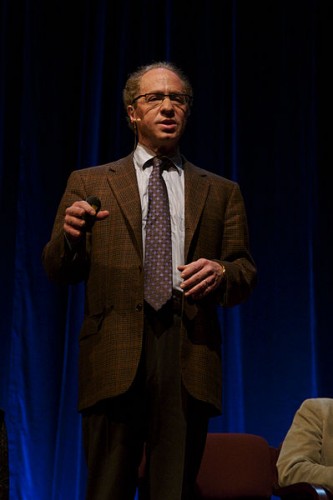
Ray Kurzweil
Futurist Ray Kurzweil made a thought-provoking presentation at a recent trade show for medical device companies, MD&M, in Anaheim, California. At one point during his 45-minute talk he shifted his attention to solar.
Explaining the accelerating rate of technical progress, Kurzweil said technical developments form very predictable trajectories, and those trajectories are exponential. Consider the progress of the computing industry, he said. He spoke about his cell phone, which he said is several billion times more powerful per dollar than the computer he used as an undergraduate at MIT.
“I went to MIT because it was so advanced that it actually had a computer in the late 1960s,” Kurzweil said. “It took up the floor of a building. Still, this cell phone is thousands of times more powerful, and million times less expensive. That’s a several billion-fold increase in price-performance. It’s also a tiny fraction of the size.”
Turning his attention to solar, Kurzweil said four years ago Google founder Larry Page and he were asked by the National Academy of Engineering to study emerging energy technologies. The men selected solar due to its exponential growth. Kurzweil said solar has been around for over 25 years, and its market share has doubled every two years.
“In 2012, solar panels were producing 0.5% of the world’s energy supply. Some people dismissed it, saying, ‘It’s a nice thing to do, but at a half percent, it’s a fringe player. That’s not going to solve the problem,’” Kurzweil said. “They were ignoring the exponential growth just as they ignored the exponential growth of the Internet and genome project. Half a percent is only eight doublings away from 100%.
“Now it is four years later, [and solar] has doubled twice again. Now solar panels produce 2% of the world’s energy, right on schedule. People dismiss it, ‘2%. Nice, but a fringe player.’ That ignores the exponential growth, which means it is only six doublings or six years from 100%.”
Two years ago Kurzweil presented this to the Prime Minister of Israel, he said, who had attended his class at the MIT Sloan School in the 1970s. Kurzweil said the prime minster asked him a question.
“Ray, do we have enough sunlight to do this with a doubling seven more times?’” Kurzweil recalled. He said he replied, “’Yes. After we double seven more times, and meeting 100% of the world’s energy needs, we’ll still be using only one part in 10,000 of the sunlight that we have.’”
“It’s not true we’re running out of energy,” Kurzweil said before moving on to another topic. “We’re only running out of resources if we stick with 19th century technologies.”
Reporting by Paul Dvorak, founding editor, Medical Design and Outsourcing